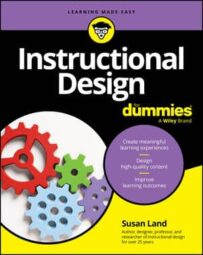Instructional design professions are sometimes referred to using different labels, such as instructional technology, learning experience design, learning design, or training. Although slightly different, all share a common focus on education and design.
In a nutshell, instructional design can be defined as a principled process of planning and creating instructional materials, activities, and technologies that support learning. The practices of instructional design are based on principles of learning and instruction, so when you use instructional design, you apply best practices for designing successful learning experiences.
The instructional design process
Instructional design is a systematic process of designing instruction. The ADDIE model is a well-known five-phase design process. ADDIE is an acronym that stands for Analyze, Design, Develop, Implement, and Evaluate. The five phases follow a general sequence that starts with analysis, then design, development, implementation, and evaluation; however, each phase works together in alignment with each other.
- Analysis: The first phase of the instructional design process is to look closely at the setting, your learners, the problem or need for the instruction, as well as the tasks that need to be learned.
- Design: The Design phase is about specifying the learning outcomes (what is to be learned) and aligning them with how you evaluate whether learning has occurred. The design phase also involves creating instructional activities, such as group collaborations, practice exercises, or designing the content material.
- Development: The Development phase is where you create the instructional materials. You create prototypes, online content, storyboards, presentation slides, videos, or print materials, just to name a few.
- Implementation: After the instruction is designed and developed, you get to try it out with your learners. Instructional designers need to plan for a variety of factors and constraints that can limit the instruction from being successfully implemented.
- Evaluation: The final phase of the ADDIE instructional design process is to evaluate if the instruction was successful. The findings from your evaluation direct you to continual improvement of the instruction.
Analysis
Examine the setting, learner characteristics, the problem or need for the instruction, and the tasks that need to be taught:
- Organizational analysis: Collect information about organizational goals, missions, or needs that may be relevant to the instructional goal.
- Context analysis: Analyze the context where the instruction takes place. What financial resources are available for the instructional project? Are the learners located in the same place or are some (or all) remote?
- Needs analysis: Analyze the performance problem or identify the need for the instruction.
- Learner analysis: Ask about the learners’ characteristics, prior experience, motivations, accessibility needs, and so on.
- Task analysis: Classify your learning goals: Remember, understand, apply, analyze, evaluate, create. Break the goals down into the major tasks and subtasks.
Design
Begin to outline how the content is learned:
- Write objectives: Create clear statements of learning objectives for each task and subtask identified in the analyses.
- Apply the ABCDs of effective objectives: Audience, Behavior, Condition, and Degree, in other words. Use action verbs for each objective for the level of learning expected.
- Create assessment items that match your instructional objectives: Creating assessment items that fall outside the scope of your instructional objectives is a sure path to learner frustration.
- Choose instructional models, strategies, and activities that best help you to achieve the objectives. When it comes to instructional design, there is a wide array of models and strategies to chose from. Choose the ones that best help you achieve your objectives, rather than the ones that have attracted a lot of buzz or have the most bells and whistles.
Development
Create or produce the instructional materials:
- Choose the mode of instruction (asynchronous, synchronous, same place, different place, hybrid).
- Select the best methods, materials, or technologies to develop for the instruction: For instance, printed manual, in-person training, video, audio, Learning Management System (LMS), video conferencing.
- Create content material, instructor manuals, scripts, storyboards, presentation slides, or digital resources such as webpages. Check that all materials and technologies are accessible for learners.
- Use best practices for project management, especially if working with a team of developers.
Implementation
Prepare facilities, materials, instructors, and learners to use the instruction:
- Try out the materials with a sample of learners in advance of the full rollout.
- Train instructors on how to teach with the instructional materials or technologies.
- Ensure that all logistical support for the instruction is completed (supplies, rosters, travel needs, facilities).
- Provide instruction and support for learners on how to use the technology (video conferencing software or LMS, for example).
Evaluation
Evaluate if the instruction was successful and if the instruction solved the problem the instruction was meant to address.
- Decide what level of evaluation the instruction needs.
- Level 1 (reaction): Did learners like the instruction and find it useful?
- Level 2 (learning): Did learning take place and were the objectives achieved?
- Level 3 (behavior): Did learners apply what they learned on the job or in their everyday lives?
- Level 4 (results): Did the learning have an impact on organizational results?
- Decide what revisions need to be made for future offerings of the instruction based on the evaluation data.

